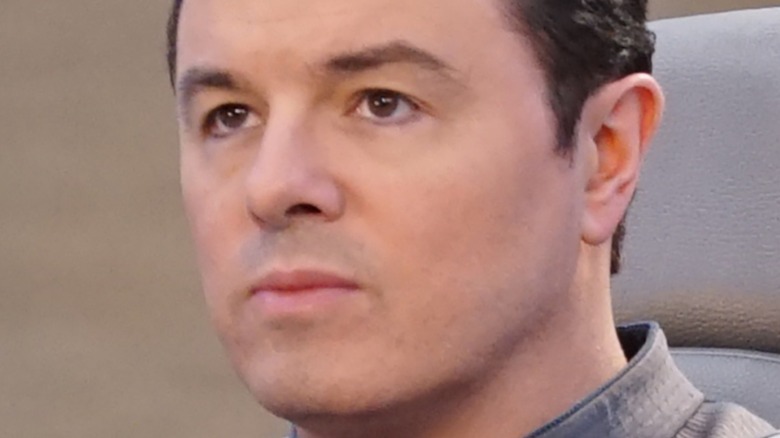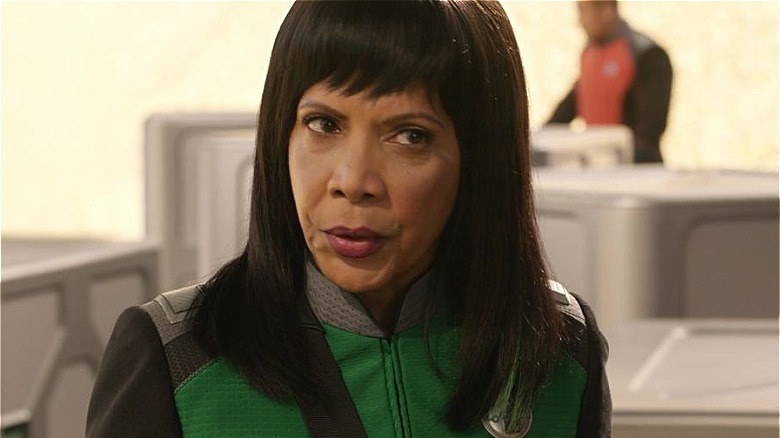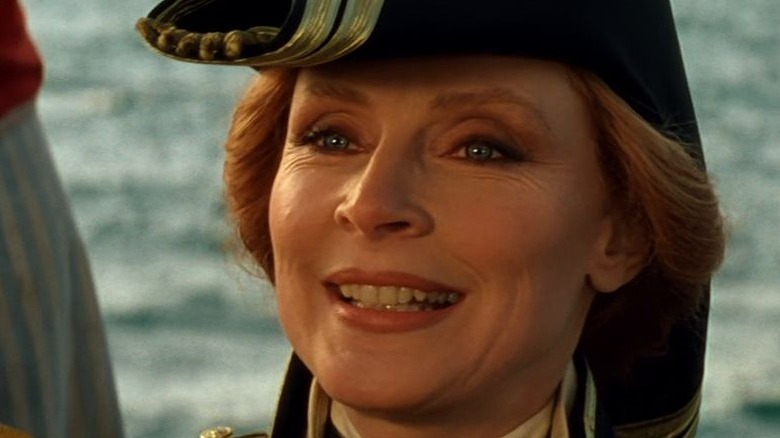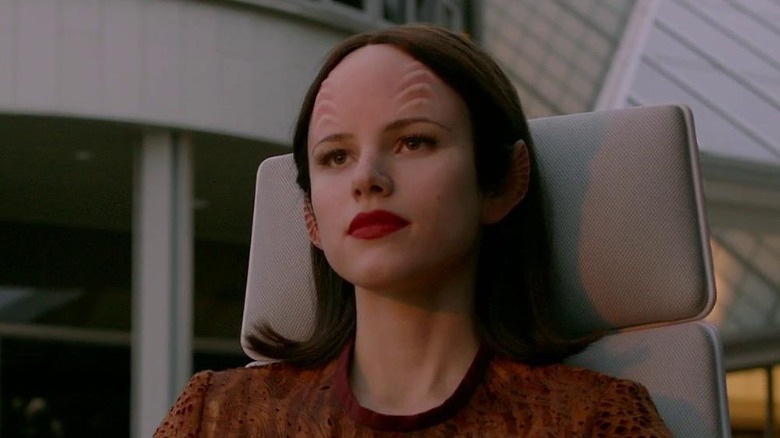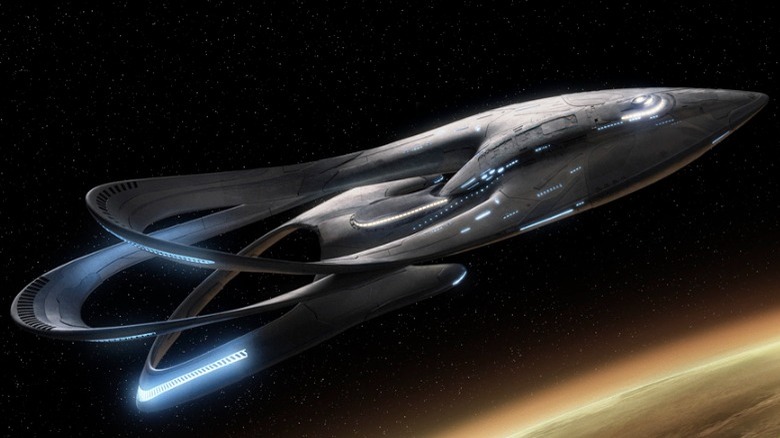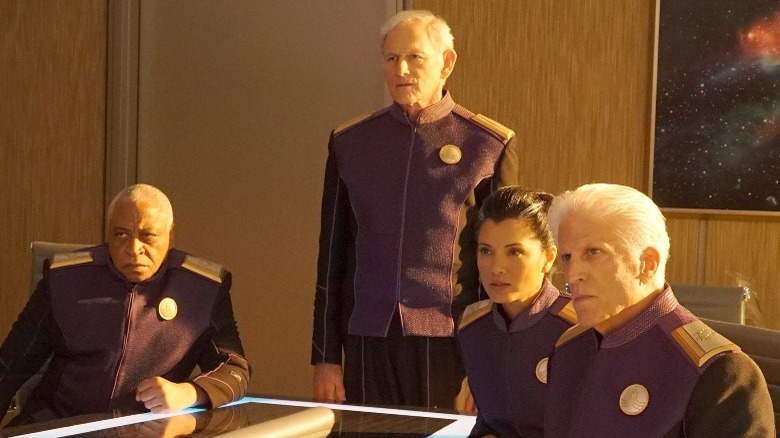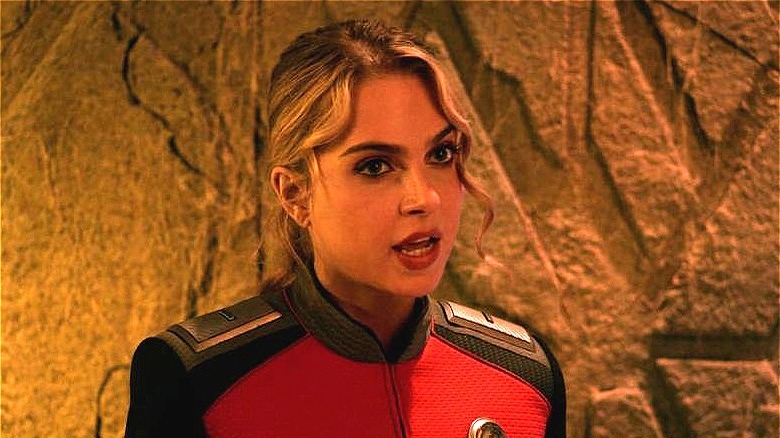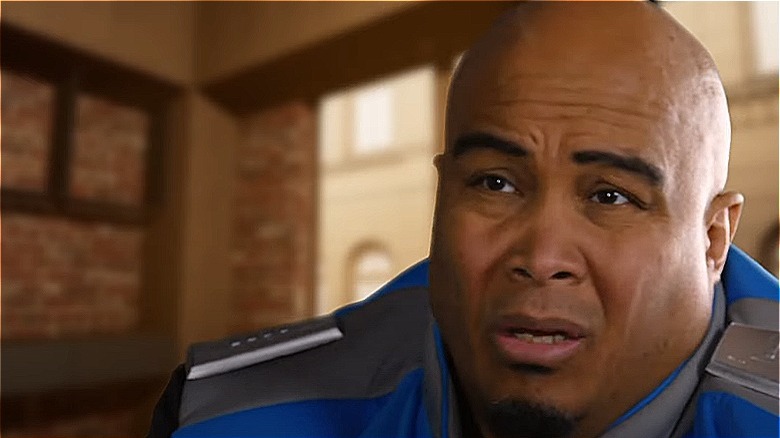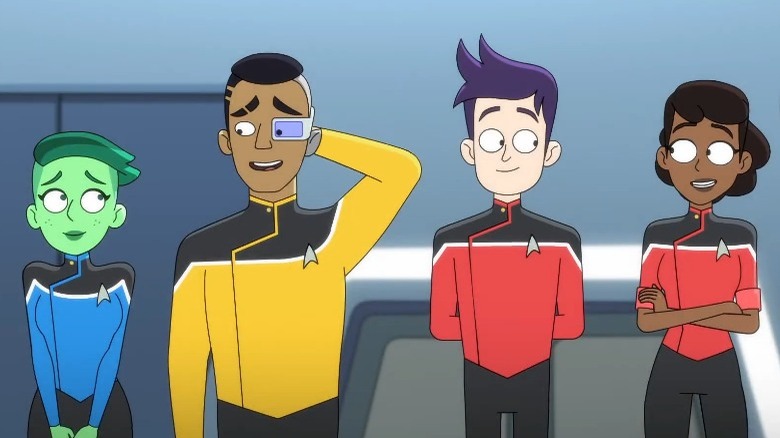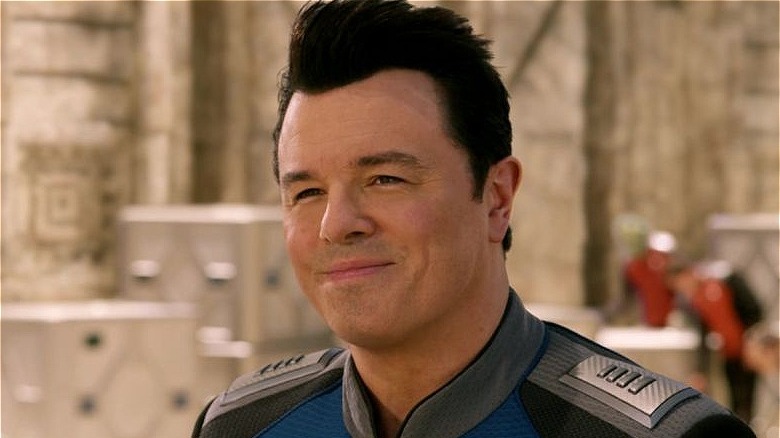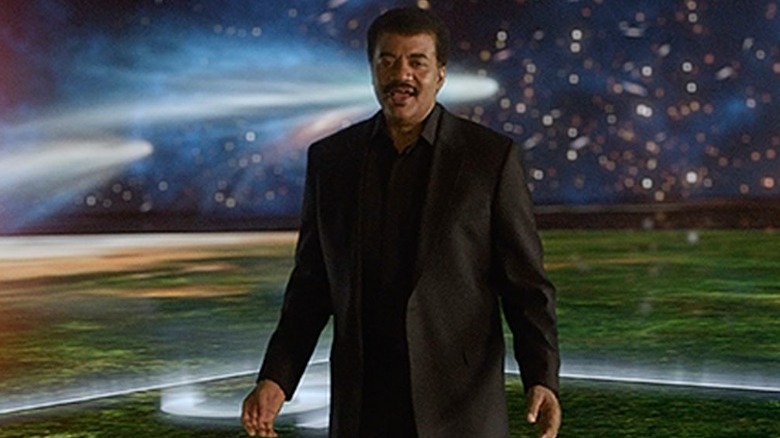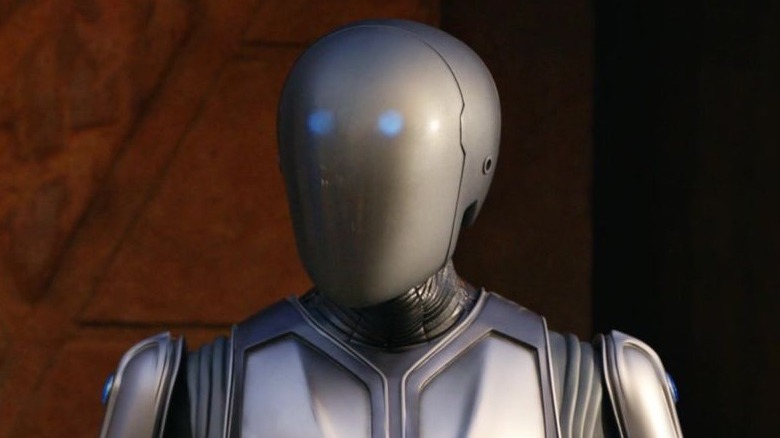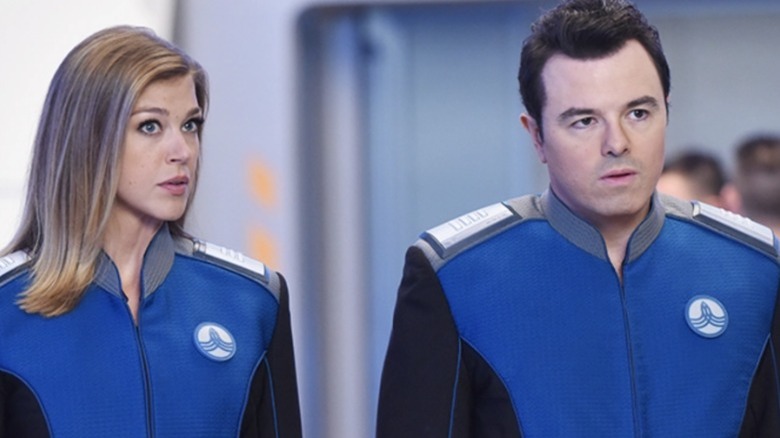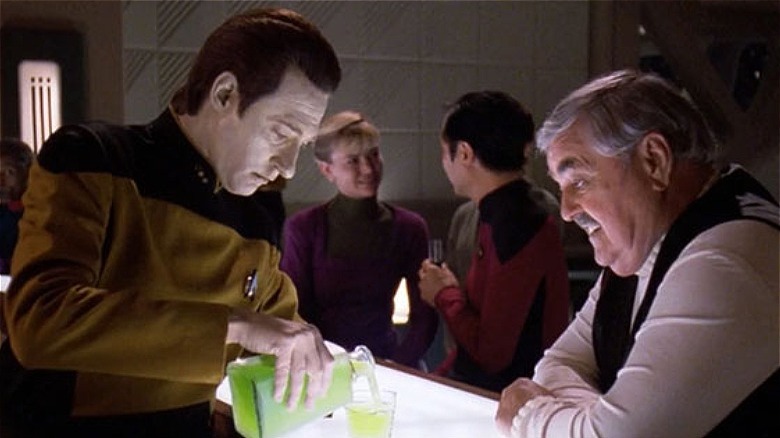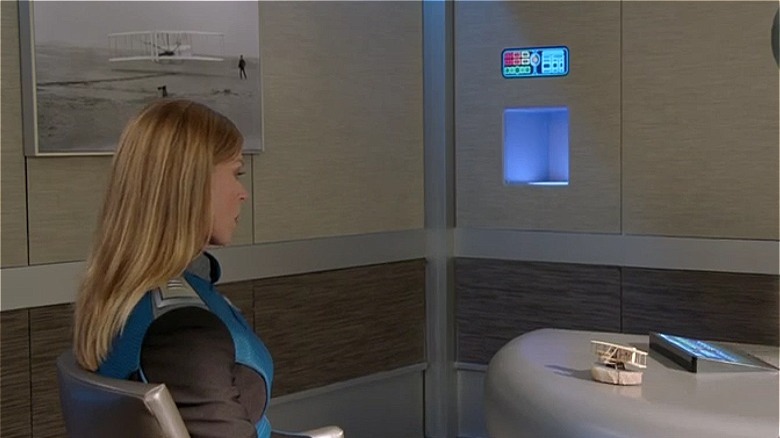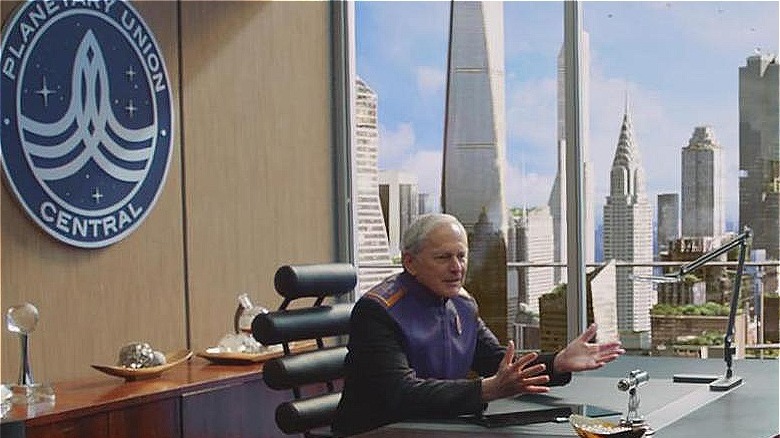The Untold Truth Of The Orville
It's hard to believe that only a few years ago, the world hadn't seen any new "Star Trek" TV shows in decades; the Kelvin universe films were the latest content. But these days, it's raining Trek, and the new shows just keep coming with series like "Star Trek: Discovery," "Strange New Worlds," "Lower Decks," and "Picard." When Seth MacFarlane released his Trek-inspired tribute "The Orville" around the same time as the "Discovery" premiere, there was a bit of controversy in the fandom, as some Trekkies saw his show as a critique of "NuTrek." As a lifelong sci-fi fan, MacFarlane is not shy about the fact that the series was inspired by "Star Trek." The series creator told Access Hollywood, "The nineties was kind of a thoughtful time for sci-fi...everything that we were fed was kind of utopian and aspirational," something he wanted to replicate in "The Orville."
While there's no arguing that some Trek series are tonally lighter than others, for many Trek lovers, there is room for everything under the beautiful umbrella of IDIC (Infinite Diversity in Infinite Combinations), and that includes the Planetary Union and mushroom-tripping tardigrades alike. Just as "Star Trek: The Next Generation" matured over its run from unfortunate episodes like "Code of Honor" and "Justice," "The Orville" is only getting better as time goes by. Because it's always a good day to hang out in a luxury space liner, let's take a look at the untold truth of "The Orville."
1. The Orville has loads of Star Trek crossovers
As a tribute to everything Seth MacFarlane loves about the "Star Trek" universe, it should come as no surprise that "The Orville" is positively brimming with Trek alumni both behind and in front of the camera. "The Orville" has featured a number of "Star Trek" alumni in the director's chair. Brannon Braga, who created "Enterprise" and wrote and served as writer and producer on two "Star Trek" series and two "Star Trek" films, is one of the producers of "The Orville" and directed four episodes in the first season. James L. Conway, who directed episodes of "Voyager," "Enterprise," "Deep Space 9," and "TNG," directed "If the Stars Should Appear." Two episodes in Season 1 and Season 2 of "The Orville" were directed by Robert Duncan McNeill, who played Cadet First Class Nicholas Locarno on "TNG" and Tom Paris on "Voyager" and "Lower Decks" and directed several episodes of "Voyager" and "Enterprise." Jonathan Frakes, Andre Bormanis, and David A. Goodman are a few other old-school Trek names involved in "The Orville's" production team.
The series has also featured plenty of actors from the "Star Trek" universe. MacFarlane himself popped up twice on "Star Trek: Enterprise" as an engineer named Ensign Rivers. Penny Johnson Jerald, who stars as Dr. Claire Finn, played Benjamin Sisko's romantic partner Kasidy Yates on "DS9." Marina Sirtis, whom Trekkies will recognize as Deanna Troi from "TNG," had a part in "The Orville" Season 2. Other Trek actors include Robert Picardo (the EMH ship's doctor from "Voyager") as Alara's father, John Billingsley (Phlox from "Enterprise"), Brian George (Bashir's father on "DS9" and Antarian Ambassador O'Zaal from "Voyager"), Brian Thompson (several villains across "TNG," "DS9," "Generations," and "Enterprise"), Steven Culp (Major Hayes on "Enterprise"), Tim Russ (Tuvok on "Voyager" and several other roles in "DS9," "Generations," and "TNG"), Jason Alexander ("Voyager"), F. Murray Abraham ("Insurrection"), and Molly Hagan (Eris from "DS9"). That's not including the actors who have played several smaller roles across the Trek universe and popped up in "The Orville." As if that wasn't enough to make "The Orville" honorary Trek, both Scott Grimes (Gordon Malloy) and Victor Garber (Admiral Halsey) were almost part of the Trek universe before ultimately having their scenes cut.
2. There are also plenty of Star Trek Easter eggs
Fans of both "Star Trek" and "The Orville" will notice that the series closely resembles the "TNG"-era aesthetic that Honest Trailers would call "an awkward hybrid of cutting-edge space battle ship and a Marriott Convention Center." The series also draws on sci-fi tropes that directly echo peak Earl Grey Trek, like the Moclan gender identity story, a callback to "The Outcast" ("TNG" Season 5, Episode 13), or Isaac's lack of emotions, which directly parallels Data's journey. Besides sharing similar storylines with its source material, "The Orville" is chock full of too many Trek Easter eggs, references, and allusions to count.
One of the more subtle references can be found in "The Orville's" theme music, which uses an electro-acoustic blaster beam instrument developed for "Star Trek: The Motion Picture" by composer Craig Huxley, who would play the 18-foot instrument for the recording of the "Orville" composition. Fans of "Voyager" will notice similarities between the two series' opening sequences, with both shows featuring their titular ships passing through solar systems before shifting into warp or quantum drive.
"The Orville" also uses quite a few names that allude to "Star Trek," like the planet Xeleyah, which alludes to Mount Seleya from "Star Trek III: The Search for Spock." The Orville universe's Moclans bear more than a passing resemblance to the Trekverse's Klingon race with their intense and warlike personalities, so it's fitting the Moclan Orville bridge officer Bortas also shares a name with a Klingon ship under the command of Duras on "TNG." Quite a few "TNG" and "Orville" episodes and storylines also follow a similar storyline or share plot elements, whether incidentally or deliberately. For example, both the pilot episodes of "The Orville" and "TNG" find the ships picking up their first officers later in the episode, and both series begin with female heads of security who are written off of the series early in the show.
3. The series is also packed with other sci-fi references
Anyone familiar with Seth MacFarlane's animated series "Family Guy" knows that "The Orville" creator's love of sci-fi doesn't end with the Trekverse. Like the Griffin family, the Orville crew constantly encounters sci-fi pop culture references in their intergalactic adventures. Finding them is part of what makes the series so much fun to watch. The series offers some obvious allusions, like Captain Ed Mercer telling his crew "May the force be with you" in the "New Horizons" trailer, as well as the clear "Star Wars" parallels in the alternate timeline episode "The Road Not Taken." The series is also rife with more subtle nods to sci-fi classics, from "Doctor Who" to "Flatland."
One less obvious example of the show's nods to sci-fi greats is the name of Norm MacDonald's sentient Gelatin Lieutenant Yaphit, which is a tribute to another interstellar engineer, Parker from the 1979 film "Alien" (played by Yaphet Kotto). Another allusion can be found in the Isaac-centric episode "Electric Sheep," a direct reference to Philip K. Dick's 1968 novel "Do Androids Dream of Electric Sheep?" The Kaylon artificial intelligence race bears a similar story and name to the sentient AI race in "Battlestar Galactica," with both races rebelling against their enslavers with an act of genocide. Even Alara Kitan's house is a reference, as the lieutenant's family home on Xeleyah is the same as Johnny Rico's in the 1997 film "Starship Troopers." Like Alara, Johnny's parents did not approve of his plans to enlist as an officer.
4. They went old school when creating the USS Orville ship
Special effects have come a long way since the early days, and today's CGI is leaps and bounds beyond the cheesy cinematic crimes that marred the TV and film of the early aughts. These days, it's practically a given that film and television producers will use computer graphics to create spacecraft thanks to the affordability and relative ease of working with this technology.
Nevertheless, the creative team for "The Orville" decided to go retro and use a practical model. As VFX supervisor Luke McDonald told postPerspective, "In this day and age, visual effects supervisors shooting models is an unheard of thing to do, but something I was absolutely thrilled about." The incredibly detailed practical model is five feet long and was created by model expert Glenn Derry. The crew took about 25 exterior shots—each requiring a minimum of six camera passes—that were then integrated with CG technology for anything that could not be accomplished with the model alone.
5. The series pays homage to the US military
"The Orville" frequently pays respect to historical military leaders in the names of the Union fleet admirals and officers. Admiral Tom Halsey, played by Victor Garber, is likely named for United States Navy fleet admiral Willam "Bull" Halsey, who served aboard the USS Enterprise in the Pacific during World War II. Another admiral, played by Kelly Hu, seems to be named for Vice-Admiral Jisaburo Ozawa, who served opposite Halsey in the Imperial Japanese Navy as the last commander-in-chief of the combined fleet, with both Halsey and Ozawa present at the battle for Leyte Gulf. The officers' names echo the "TNG" episode "Redemption, Part II," which featured two ships named for the carriers Akagi and Hornet, which were present at the Battle of the Midway.
Admiral Perry (played by Ted Danson) is named after Admiral William Perry, who is a member of a legacy U.S. Navy family. The Orville's first officer Kelly Grayson may be a nod to the famous U.S. Navy surgeon Cary T. Grayson, and Charly Burke is likely a reference to Arleigh Burke, a distinguished U.S. Navy admiral who served in both World War II and the Korean War.
6. The show is a family affair
For "The Orville" creator Seth MacFarlane, every day is Take Your Family to Work Day, whether he's commanding a Union ship or working on one of his animated series. MacFarlane's family is sewn into the fabric of the series through Captain Ed Mercer's name, which is taken from the MacFarlane family tree and has popped up in several MacFarlane productions. Just as Gene Roddenberry's wife Majel Barrett voiced the computer on "Star Trek," MacFarlane turned to a member of his family—his younger sister Rachel, who also played Hayley Smith on "American Dad!"—to voice the USS Orville's computer.
MacFarlane also surrounds himself with friends when casting his TV shows. MacFarlane's relationship with Scott Grimes (Helmsman Gordon Malloy) goes back a couple of decades, with Grimes telling CinemaBlend that he deeply values their collaborative relationship. MacFarlane's relationship with J. Lee began on the set of "Family Guy." According to IndyStar, Lee was a trained classical pianist with Hollywood dreams when he started working as a receptionist for "Family Guy" and quickly formed a friendship with MacFarlane that led to voice acting roles on several of MacFarlane's animated series and even a writing credit. According to Collider, Adrianne Palicki and MacFarlane are "really, really dear friends." The series has also featured a few of Seth's girlfriends over the years, including Halston Sage (Alara Kitan), Anne Winters (Charly Burke), and Seth's former girlfriend Jessica Szohr, who plays Talla Keyali.
7. There is an Orville fan series
One of the great things about beloved sci-fi shows like "Star Trek" and "Doctor Who" is the creativity they inspire in their fans. Over the years, "Star Trek" fans have created quite a few fan productions, ranging from silly to productions that give the canon a run for its money, with "Axanar" and "Star Trek Continues" among the best-loved within the fandom. In 2020, Together Brothers Productions continued this tradition with the Orville universe fan film and series "A Planetary Step," which revolve around Planetary Union Captain David Gerald's adventures aboard the USS Eisenberg. The fan series was directed by Jason Richardson and was written by Eric Moran (who plays Gerald) and Brian Terranova. On "Talking the Orville," Moran—a professional cosplayer who has worked as a writer and actor on several fan productions in the "Trek," "Judge Dredd," and "Spawn" fandoms—shared his hope that the series would inspire other fans to create their own Planetary Union fan productions.
8. There was almost an animated version of The Orville
With Seth MacFarlane's extensive animation background, it only makes sense that Planetary Union would show up in line art one of these days, just as Trek has so many times over the years. Super-dedicated "Star Trek" fans will remember 1973's "Star Trek: The Animated Series," which originally aired as a Saturday morning cartoon and has spawned plenty of debate over what is or is not official Trek canon among the fandom. More recently, Trek fans have enjoyed a few animated episodes of "Short Treks," including the adorable "Ephraim and DOT," which saw a colorful space tardigrade and a DOT-7 drone engage in Tom-and-Jerry style cartoon hijinks around the Enterprise. The recent Trek renaissance also gave rise to the Nickelodeon series "Star Trek: Prodigy" and the adult comedy animation "Star Trek: Lower Decks."
Fans hoping to see an Orville animated series in the same tradition may not have anything to look forward to yet, but it should come as good news that the thought has crossed MacFarlane's mind. Seth MacFarlane told io9 that the producers considered making some animated episodes during the pandemic but there "wasn't an appetite for it" at the time, noting that he was still open to the possibility down the road.
9. Both Seth and Ed aren't huge stoners
There's no doubt that Seth MacFarlane brings a lot of his own personality to the character of Ed Mercer. Both are eternal optimists with a positive leadership style that brings out the best in their teams. Ed Mercer looks up to Kermit the Frog as a role model and MacFarlane seems to be a fan of the Muppets as well. MacFarlane even covers "The First Time It Happens," an original song written for "The Great Muppet Caper," on his album "In Full Swing." Like the famous frog, both Ed Mercer and Seth MacFarlane agree that it ain't easy being green.
In the episode "Command Performance" (Season 1, Episode 2), it's revealed that the captain's bad experience with some strong bud led to a paranoia-fueled outburst at the opera. Like the captain he plays, MacFarlane, who is himself an advocate for the legalization of cannabis, never had much of a personal taste for the devil's lettuce, at least not for the first three or so decades of his life. The director told Jimmy Fallon he was probably around 28 years old before trying despite having hippie parents who were more than approving. He did eventually learn to appreciate a casual toke or two.
10. Seth MacFarlane works hard to get the science right
Like many sci-fi fans who grew up loving "Star Trek," Seth MacFarlane adores science. His passion for space began as a child watching Carl Sagan's "Cosmos," which inspired MacFarlane to reboot the series for a new generation. In an interview with Los Angeles Times, MacFarlane explained his belief that it's more important today than ever to get audiences engaged with science. As such, MacFarlane has put a good deal of effort into presenting plausible, accurate science in the shows he produces, especially "The Orville."
Speaking to Ars Technica, science advisor André Bormanis emphasized how "grounded" MacFarlane is in the science side of his storytelling with everything from DNA models to the theory behind the ship's quantum drive. With a physics degree and a master's in science, technology, and public policy, NASA fellowship recipient Bormanis served as a science consultant on several Trek productions as well as director of scientific research for "Cosmos: A Spacetime Odyssey." "The Orville" also receives science insight from rock-and-roll astrophysicist Neil deGrasse Tyson, who came on board during the show's second season.
11. Isaac (Mark Jackson) records all of his lines twice
All the actors who bring the USS Orville's bridge officers to life have worked hard to elevate the series beyond a simple "Galaxy Quest"-style Trekverse parody, and all deserve credit for their efforts. One of the most incredible and ironically powerful performances has been that of the emotionless artificial creature Isaac, played by Mark Jackson. In every interview with Jackson, it's adorably clear that the actor loves playing Isaac despite having to act with his face covered most of the time. The writing has more than done his character justice by giving him complex and challenging story arcs; the Kaylon experienced a relationship, dealt with the realization that he has betrayed everyone who loves him, and struggled with the pain of experiencing deep emotions only to lose them.
Not only has Jackson been nothing short of spectacular in his portrayal, but he's had to record every scene twice thanks to the challenge of playing in a full-body costume with his head covered. During his performances with the other actors, Isaac's lines are too muffled to understand on camera, so they have to be recorded a second time using ADR before the scene is put together. In an AMA Reddit thread, Jackson explained that he thinks of himself as a "puppeteer" when playing Isaac and uses a headphone called a Comtech that helps him hear more clearly when in costume. When playing Isaac, the actor also explained that his vision is at about 75% and he relies on others to help him get around safely.
12. Seth is shorter than Ed Mercer
To create the shows that we love, TV showrunners use plenty of tricks of the trade to help make everything look perfect. Sometimes, those tricks involve a little cinematic sleight-of-hand to create the perfect scene. Like most great TV shows, "The Orville" crew occasionally plays with what's on screen and most audience members never realize it. One common trick used in television is a height-evening method known as a "Scully box," named for the 5'2" actress Gillian Anderson, who played Dana Scully on "The X-Files." Since height differences can make filming scenes with two or more actors tricky, sometimes it's just easier to help even things out a bit. Offscreen, Adrianne Palicki, who plays Kelly Grayson, is an inch taller than Seth MacFarlane at 5'11". Onscreen, however, Captain Mercer appears just a smidge taller than his second-in-command, so it's likely the actor wears platform boots as part of his costume.
13. The actors drink real alcohol on set
In the post-scarcity Federation of "Star Trek," the Enterprise crew is free to explore the galaxy knowing that they can create just about anything they want or need using their handy dandy replicators, from Deanna Troi's chocolate treats to Captain Picard's Earl Gray, hot. One thing that does seem to be scarce in Starfleet is a decent drink, thanks to the emergence of booze's boring little brother, synthehol, which won't get you drunk unless you're Seven of Nine.
Fortunately for the crew of the Orville, the Planetary Union has no such teetotaling qualms. Officers and ensigns alike regularly imbibe on everything from whiskey to oppsada, a Moclan drink containing a parasite that apparently feels pretty darned nice to get infested with, although we'll have to take Bortus and Klyden's word for it. According to Forces of Geek, the liquor on set is real —at least some of the time, that is. According to Scott Grimes, "There are scenes filmed in the mess hall, and I go to take a sip and they're rolling film and someone has switched the glass to real whiskey and that's a real reaction!"
14. The ship's name is an homage to the first flight
Fans of "Star Trek: Enterprise" know all about the history of flight and space travel thanks to the show's introduction. Set to a cover of "Faith of the Heart," the intro is a montage of the exploration, aviation, and aerospace innovations that led to Starfleet's launch of the original starship Enterprise under the command of Captain Jonathan Archer (Scott Bakula). Just as the name of Starfleet's flagship recalls famous Enterprises through the ages, from the HMS Enterprise to the nuclear-powered aircraft carrier USS Enterprise (CVN-65), Seth MacFarlane named one of the Planetary Union's ships after one of the first aviation pioneers, a guy named Orville Wright. The younger of the two Wright brothers, Orville helped his brother Wilbur innovate and fly the first sustained powered flight in Kitty Hawk, North Carolina in 1903. During the first season of the series, a model of the Wright flyer can be seen on Ed Mercer's desk, and a photo of the first flight decorates his office wall.
15. There have been Planetary Union flags in space
Besides the incredible scientific discoveries that happen aboard the ISS, there's also a surprising amount of geekery afoot. From Commander Chris Hadfield singing "A Space Oddity" while overlooking the Earth to Italian European Space Agency astronaut Samantha Cristoforetti cosplaying as Starbuck from "Battlestar Galactica" and Captain Janeway of "Star Trek: Voyager," the ISS is practically a little mini Comic Con these days.
That's why it should come as no surprise that the marketing geniuses at The Space Collective regularly launch geeky merch into space and then bring it back down to Earth for willing fans to throw money at. Back in 2020, while the world was hunkered down in pandemic mode, they launched a payload of Planetary Union flags. After arriving in space, the payload was placed outside of the airlock with a robotic arm. From there, the flags hung out for half a year outside the ISS, orbiting the planet Earth and soaking up cosmic rays and other space weirdness. Let's just hope the Krill didn't see them, or we're all in trouble.
